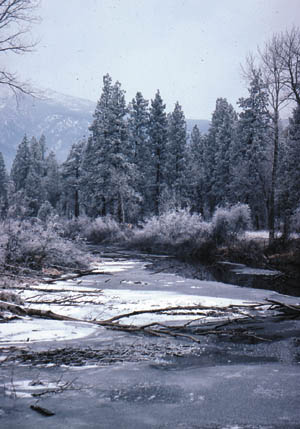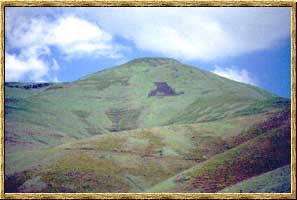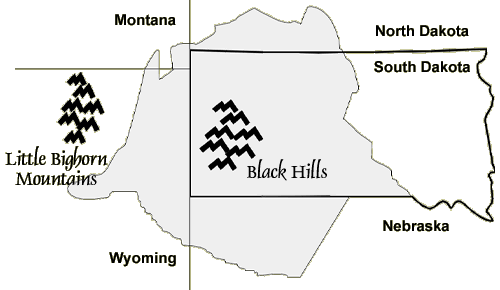|
|
Canku Ota |
|
|
(Many Paths) |
||
|
An Online Newsletter Celebrating Native America |
||
|
July 14, 2001 - Issue 40 |
||
|
|
||
|
This Date In |
||
|
North American Indian History |
||
|
from On This Date in North American Indian History at http://americanindian.net |
||
| July 14, 1837: | At Fort Clark, on the upper Missouri, Francis Chardon records the first death of a MANDAN attributed to smallpox. The outbreak of this disease will spread rapidly and be extremely deadly to the people in this area. |
|
|
|
| July 15, 1948: | An Arizona court say Indians can vote. |
|
|
|
|
|
|
| July 16, 1855: | Treaty with 3 different Indian nations is concluded at Hell Gate in the Bitter Root valley. The treaty will establish the FLATHEAD Indian Reservation in Montana. |
|
|
|
| July 17, 1866: | Early in the morning, on this date, OGLALA SIOUX steal almost 200 horses and mules from Fort Phil Kearny's stock, in northern Wyoming. In addition to acquiring the mounts, this is a plan to draw the soldiers out of the well defended fort. When the soldiers ride out to try to win back the animals, the Indians attack. A running battle ensues. This will be the start of a summer of constant hit-and-run attacks by the Indians. |
|
|
|
| July 18, 1942: | The SIX NATIONS declare war on the Axis Powers. |
|
|
|
|
|
|
| July 19, 1991: | Today, Congress creates the NEZ PERCE Historical Trail Foundation. The Foundation is established to mark the trail the NEZ PERCE took on their flight from the Army in 1877. The Foundation will be administered by the United States Forest Service and the NEZ PERCE. |
|
|
|
| July 20, 1863: | General James Carleton, called star chief by the NAVAJOs, has ordered the NAVAJOs to leave their homeland and to report to the Bosque Redondo Reservation in New Mexico. All NAVAJOs found off the reservation, after this date, will be considered "hostiles", and will be treated accordingly. No NAVAJOs turn themselves in, leading to the Canyon de Chelly Campaign, and the "Long Walk." |
|
|
|
| July 21, 1806: | CROW Indians steal 24 of Lewis & Clark horses. |
|
|
|
| July 22, 1996: | Today, in Syracuse, New York, Leon Shenandoah died at 81 years of age. Shenandoah was a leader of the ONONDAGA Indians. In 1969, he was named the Tadadaho, or the Spritual Leader, of the IROQUOIS Confederacy. Shenandoah lived almost all of his life on the ONONDAGA Reservation in New York state. |
|
|
|
|
|
|
| July 23, 1851: | At the Traverse de Sioux today a treaty is concluded between the United States and the "SEE-SEE-TOAN" (SISSETON) and "WAH-PAY-TOAN" (WAHPETON) Bands of DAKOTA or SIOUX Indians.(10 stat.949). |
|
|
|
| July 24, 1977: | COMANCHE & UTE end hunting dispute. |
|
|
|
| July 25, 1952: | Public Land Order 858 will be modified today to remove certain lands in the Fort Peck Reservation, in Montana, from the classification of being "opened for disposal" under public land laws. |
|
|
|
| July 26, 1865: | Following the massacre at Sand Creek, many Indians began attacking military outposts, and people crossing their territory. A group of CHEYENNE, led by Roman Nose, wanted revenge for lost relatives. They approached a bridge across the North Platte in what is now Casper, Wyoming. The bridge was also the site of a telegraph station and a military outpost. After trying for two days to get the soldiers out of the fort, a column of troops cross the bridge. The Indians attack and kill many soldiers, including Lt.Casper Collins. Another column of troops comes to the rescue, and cannon fire from the fort helps them escape. The soldiers had left the fort to provide an escort for an approaching wagon train. Another band of Indians attacks the wagon train. During the fighting, Roman Nose's brother is killed. Roman Nose lead a charge against the wagon train and all of the soldiers guarding it are killed. Their anger quickly dissipates, and the Indians quit the fight, and leave the area. |
|
|
|
|
|
|
| July 27, 1889: | It was not much time after the establishment of the "Great SIOUX Reservation" that the U.S.Government decided to try to reduce the Indian's holding once again. The plan was to establish several smaller reservations, and to open up millions of acres for white settlement. Led by General George Crook, the treaty commission arrives at Standing Rock agency to convince the SIOUX to sell their lands for $1.50 an acre. A previous commission's efforts to offer them fifty cents an acre had failed miserably. |
|
|
|
|
For Information on This Date in Canada visit our friends at: |
|
Canadian
Aboriginal News |
|
|
||
|
|
||
| Canku Ota is a free Newsletter celebrating Native America, its traditions and accomplishments . We do not provide subscriber or visitor names to anyone. Some articles presented in Canku Ota may contain copyright material. We have received appropriate permissions for republishing any articles. Material appearing here is distributed without profit or monetary gain to those who have expressed an interest. This is in accordance with Title 17 U.S.C. section 107. | ||
|
Canku Ota is a copyright © 2000, 2001 of Vicki Lockard and Paul Barry. |
||
|
|
|
|
|
The "Canku Ota - A Newsletter Celebrating Native America" web site and its design is the |
||
|
Copyright © 1999, 2000, 2001 of Paul C. Barry. |
||
|
All Rights Reserved. |
||




